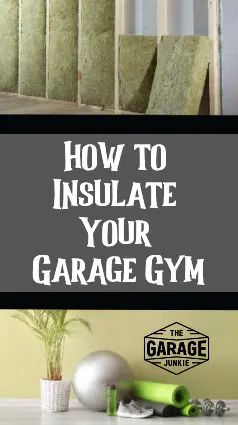We often have many excuses to skip our gym sessions. Sometimes you convince yourself that you cannot make it to the gym due to bad weather. Why not create a home gym, and stay fit all year round? A garage gym, for instance, requires effort and a little expertise to put up, but once it is done, you will be immune from all inconveniences of walking or driving to a gym far from your place of residence.
One of the most important aspects of a home or garage gym is proper insulation. Controlling the temperature will help to prevent injuries and keep you motivated to keep up with your workout. In this article, we will show you how to insulate a garage gym through proper flooring, insulating the door, wall, and windows, as well as installing a heater. You should also dress warmly and do your warm-up in the garage gym as you wait for the heater to heat the room. Do not forget to keep your training equipment warm so that they are not too cold for your bare hands.

1. Fix Appropriate Flooring in Your Garage Gym
If you live in a place with frigid winters, a bare cement floor will feel so cold. And truly, there is no way of warming it up. This means you will be exposing yourself to chilly temps while you work out, which is not suitable for your health.
The feel of the cold floor on your feet will also discourage you from staying in the gym until you complete your training session. You will not be motivated to come back for subsequent workouts.
Besides, the cold from the floor will find its way on the workout equipment, your bench, power rack, and everything else. One feel of an ice-cold weight is enough to send you out of that garage gym and stay away for a couple of months.
https://amzn.to/3yzReOyThe best way to insulate your garage gym floor is by installing a rubber coat or Puzzle Exercise Mats, which are made of interlocking Foams Gym Mats. They protect the floor as well as keep it warm. To reduce the direct contact between the cold floor and the mats, you can use a Polycuramine garage floor coating which works well with concrete floors.
This will make it feel warmer and help you control your balance and stability when working out. Rubber is good for reducing the impact on your feet, back and joints, keeping you free from training-related injuries.
2. Garage Gym Insulation
They next step is to inspect your gym on a cold day to identify the spots that are letting in the draught. Here are some of the likely culprits for lowering your gym’s temperature:
The Garage Door
If, like most people, your garage door is made of thin metal, you can be sure it invites draught unhindered. You can reduce this by installing tiles on the door. Look out for the seal at the bottom part of the door, the sides, and top, and seal them completely. The benefits
If you are not sure what to use to insulate the garage door completely, take a picture of the door, go with it, or send it to your home improvement store. They will advise you on the right materials to use to seal your door. Get a garage door insulation kit at Amazon, complete with everything you will need. You can also check out our article on how to insulate a garage door.
The Window
Most people do not insulate their garage windows. Do you know insulating all the windows in your house is one way of lowering your power bills? Cover them with a plastic window film to keep away cold air and reduce the demand for heating your home. This also applies to your garage. Cover up that window, and the room will stay warm.
The Walls
If you look at your garage wall, you may notice that some are not insulated. Use fiberglass insulation to get instant garage gym insulation; another great alternative is the Reflective Polyethylene Insulation Roll; it helps retain heat and provides sound reduction; hence, it is easy to install by hand without a mess or fumes. If your walls are unfinished or you’d like a more info on insulation, read on here: (link to basics of insulation).
Doors
If you have exterior doors leading to your garage, check them and seal them completely. Be keen to inspect the frame, kick plate, and bottom seal to ensure they provide maximum coverage to keep out cold air. Moreover, if these doors have windows, cover these too with plastic window films.
Inspect the Insulation
After doing all this work, you want to be sure you have successfully insulated your garage gym. The easiest way to find this out is to light a candle and walk around the gym holding it. If the candle is blown off, you will know the culprit. And if it remains on after passing it by the doors, windows, and wall, then you can pat yourself on your back to successfully insulating your workout space.
If you live in an area where the air is more stagnant, you can also look for any light from outside peeking through joints or thresholds.
3. Install a Heater in Your Garage Gym
A heater in your garage will warm not only the room but also the training equipment. This, however, will depend on the size of your heater and its position. Do not get us wrong. We do not mean that a bigger heater works better than a smaller one. Sometimes the model of the heater matters than the size.
Some heaters send heat in one direction, but others can heat a room from the back and the front. Choose the heater within your budget and position it correctly in your gym. The best place to put it is where it will heat the room and the training equipment. You can turn on your heater some minutes before you go to the gym. This will be better if the heater has a remote control.
4. Pre-Workout Warm-Up in Your Garage Gym
Your heater takes some time before warming your room. You do not have to wait until the room is heated to begin your workout warm-up. Begin as soon as you switch on the heater, and by the time the room heats up, you will be ready to begin your training.
Doing so will help you lower your power bills since you will have the heater on for less time. If you are using a portable heater, you may need to place the heater in another room after you are done with your gym session. It, therefore, makes sense to warm up when you put on the heater so that you can reduce the time the heater stays in the garage gym.
5. Layer Up
This looks obvious, but if you overlook dressing appropriately, you may not enjoy your gym sessions. At some point, you will take out some layers as your body warms up, but ensure when you dress to go to your gym; you are well covered. So, how do you dress well for the gym? Take a look at this:
Base layer
This layer is significant for wicking away sweat from your body. The best materials for your base layer are merino wool and synthetic fabric with spandex, rayon, nylon, and polypropylene. While wool is naturally soft, warm, and absorbent, synthetic fabrics are thinner and expand better.
Insulation Layer
This layer traps and retains heat around your body. A light sweater or a long-sleeved shirt will serve this purpose. Pair them with fleece trousers, and you will be ready to generate and retain heat as you train.
Outer Layer
This may be necessary before your body warms up or when warming up outdoor. However, expect to chuck it out as soon as your body is ready for rigorous training. It may consist of a waterproof training jacket and a hood.
Cover Your Extremities
The hands and feet need proper cover too. Look for comfortable training gloves and socks to keep them warm as you work out. While you may not stay with the gloves throughout your session, ensure you wear them when touching steel items in the garage. Do not forget to cover your head and ears too. If your jacket has a hood, pull it over your head. You can also get a hat that covers your head and ears.
6. Insulate the Equipment in Your Garage Gym
You may not have your gloves on all the time, yet the ice-cold steel may be uncomfortable for your bare hands. There are ways of going around this and ensuring the dumbbells, kettlebells, and pull-up bar are warm and ready when you need to pick them.
For starters, you can place them where hot air from the heater warms them up. But if this is not possible, you can still warm them up using some gym hacks. One way of doing this is by covering them in chalk. Or, if you know that your garage gym is going to be weathering some extreme temperatures, you can also look for equipment that has a plastic or rubber grips as one of the features.
After all, the trick is to put a layer between your hand and the hard steel. Another option is to try to warm up your training equipment by placing warm towels on them. This may take a little planning, but if you throw a gym towel or two in the dryer for a few minutes before your workout, it will be ready to warm up your chilly dumbells and pull-down bar.
Conclusion
A warm gym will motivate you to keep up with your workout plan. Begin your garage gym insulation by putting a rubber cover on the floor. Ensure that the doors, windows, and walls are insulated. Install a heater in your gym that you should turn on some minutes before beginning your workout. The heater should warm the room and the equipment.
Most importantly, dress warmly for your training sessions so that you can generate and retain heat in your body. You may have to shed off some layer of your training clothes when you begin to sweat. Do not forget to cover your head, hands, and feet. In case the dumbbells, pull-up bars and, kettlebells are not warmed by your heater, cover them with chalk or a warm towel.
For more tips during the hotter months of the year, check out our articles on 10 Ways to Cool Your Hot Garage and best garage gym fans.
